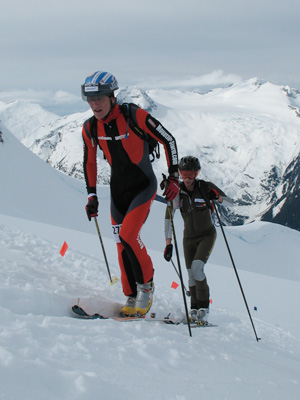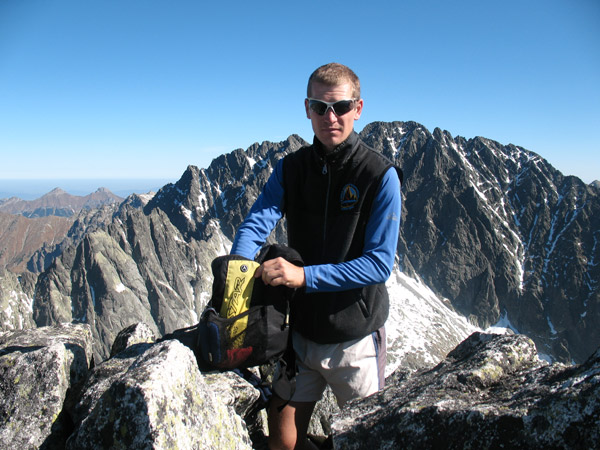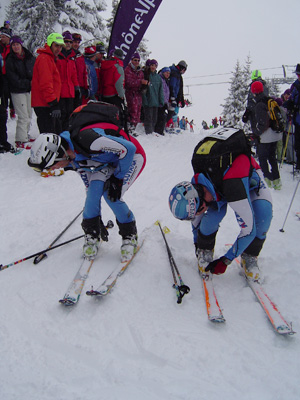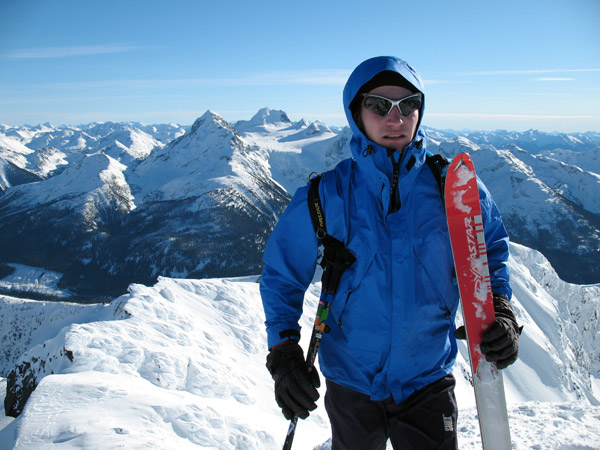To progress Canadian and American ski mountaineering racing further we have to learn from each other but more importantly from those that are doing it longer than us.
Since one of my good friends is a world class ski mountaineering racer I asked him to share some knowledge (via an interview) that would take us long time to gain or to confirm.
A bit of background info

What made me interested wasn’t that I had a friend participating in “not a main stream sport” because in Europe ski mountaineering racing has been quite popular for long time by then.
But what made me über interested and involved was his progression and a passion as a racer.
The racing goals that Peter achieved in ski mountaineering are truly impressive considering the background he was coming from. Born and raised in Slovakia, a non-Alp country without a single glacier and without rich snow falls, he was lucky to start skiing quite early thanks to his parents. But shooting for sporting international success requires all your being in this Eastern European state.
After couple of years of super committed approach and support from his parents Peter was able to progress to international level racer. Since then, here and there, he has been able to support his development further with a help of scarce but passionate sponsors. However, his racing activities are still mainly depended on his own financial efforts and his family’s support.
Fortunately, smart and hard training usually pays off if you stick around long enough. And linking a year after year of the most sport committed lifestyle I ever saw Peter progressed in the modern era of super competitive skimo racing further than many thought was possible.
Here is a summary of his biggest international achievements, besides countless national level wins:
- bronze medals from World and European Championships
- 3rd place and couple of top 5 finishes at Pierra Menta – the biggest race in skimo racing
- 1st place at Whistler’s High Range Classic in 2007
- 5th place at the super long marathon event at the Worlds in 2008
- and many more achievements that are highly respectable
Now the goods – Peter talks racing
Here, via couple of questions, I asked Peter to share his experience and provide us with some tips and advice that might help us progress our passion further than we ever thought was possible.

I competed in my first skimo race as 18-year old in 1995. Back then there were no junior categories, so I had to wait until I was legal to race. Before that I raced in cross country skiing.
My training was mostly dependent on what kind of race I was preparing for. But usually longer events suit me better thus my training was also geared more towards that.
Q: What do you think made you develop from a top national level racer to stand on some world’s prestigious podiums?
This was due to lots of experience I was able to gather at home events in Slovakia…and lots of commitment of course.
There were couple of racers in Slovakia back then that were quite competitive in the European Cup (now it’s called World Cup), therefore, I could compare against some high level racers.
Then once I was able to beat them at home I knew I could be ahead of them in the international races too. So this experience was what gave me a lot, including lots confidence.
Q: You are known to be able to prepare very well for your targeted goals. What are some of the things you watch for and do in training to be 100% when you need to be?
Everything is about a very committed approach. Over the years of racing I know myself very well, I learned what works for me. The only things that usually limit me are the time available to train and financial issues.
Q: What sports do you do in the summer? Which ones serve you well in preparing for ski mountaineering races?
I mostly ride my mountain bike or my road bike during the summer, and I also trail run a lot in the Tatra mountains.

There were some high quality racers especially from places like Colorado, Montana and Wyoming. At other places, the racing form of ski mountaineering wasn’t developed much because people mostly prefer to do the sport without any competitive ambitions.
During the time when I was there everything was heading in the right direction, towards attracting more people into skimo racing. But what I missed was an involvement of young athletes. Of course, this is related to opening new categories for 15 to 18 year olds, which were non-existent back then. Are they now?
Simply any country that wants to have world class athletes in the future has to start working with the youth.
Q: Most of North America racers are about 30 years old which might be a little bit too late for starting to be competitive, but we all have good endurance base from long days in the mountains. What would you recommend to focus on primarily in training in order to get faster?
Of course, anyone who starts to compete in skimo racing after teenage years, and doesn’t have any experience with racing in this sport, won’t excel in speed. However, this speed can be trained quite well even latter but it requires lots of strong will and commitment to train systematically.
One of the best methods to train speed is to include a speed workout once a week in your program, year round. During the summer it is enough to include 10sec full-on sprints in one of your endurance workouts. Do around 6-8 of them separated by plenty of time of active rest (spin, jog).
Q: What do you think racers and organizers in developing skimo racing countries need to do in order to get to world class level in the future? How long it can take before even one NA is consistently in the top 15 of the biggest races?
As I mentioned before, it is all about committed and systematical work with the youth. The bigger the base pool the better the chance that someone will make it to the elite.
Personally, I think that North America can have as many talents as Europe has. You guys have very good predispositions – great terrain environment, could have great financial support and the culture, especially in US, makes you very ambitious.
The more races you will organize the more experience and skill can racers gain. Then the sport will gain more exposure and that will attract more sponsors.
I believe that North America can take this sport to another level if you guys will have quality racers since this will create more interest, therefore, giving it a higher level and a bigger chance to get included in the Olympic Games.
Q: For sure we are not the fastest but what strategy can we use at the upcoming world championships to have a bigger chance of higher placing in the standings? For example – start fast or slow, pace evenly…
It is a bit difficult to advise someone I don’t know. But in general, if a racer feels that he gave everything through an evenly paced performance he will have a better chance of success than somebody trying to run with the best from the start for as long as he can. Simply, he will be missing too much energy at the later stages.
Q: What is it like to compete in various European countries? For example compare some differences between competing in Slovakia, Italy and France.

At Italian Cup races there is often as strong competition as at any World Cup event.
There are races that are way more prestigious than World Cup events or World Championships.
In France, Italy and Switzerland there are these three monuments – Pierra Menta, Trofeo Mezzalama and Patrouille des Glaciers.
Those events aren’t usually part of the World Cup circuit but popularity and attendance are over the roof.
Q: Who are currently the best skimo racers in the world right now?
The very best because they are the most consistent are Italians Manfred Reicheger, Denis Brunod and Guido Giacomelli. Then Swiss Florent Troillet, Spaniard Kilian Jornet and Frenchman Florent Perrier.
Q: At last some questions equipment. What skis and boots will you will be racing this season?
For ski boots Pierre Gignoux 500 and for skis most likely Ski Trab.
Q: You are 186cm tall, how long are your racing poles?
My racing poles are 138 cm long.
Q: What skins do you use for competition and why?
I use Colltex and Pomoca skins and I choose which one based on conditions.
Colltex skins usually glide better in a new wet snow and some times also on an absolutely frozen-through powder (frozen soft snow). Their disadvantage is that the glue is not as good as Pomocas have. I can put on Colltex skins for two maximally three climbs during a race.
Pomoca skins glue better to even a wet ski and you can use them for more climbs.
I usually test which skins I will use for a race the day before and I stick with that as the conditions usually don’t change too much over night.

I don’t use the same equipment as there is no way I could afford that. I have a separate set for training because I am saving my best gear only for the biggest races.
I race my training equipment even at most of the races, only when I go to compete against the world’s best I pull out the carbon stuff.
So, my training skis are the same length and width but they are a bit heavier. Then for boots I use Scarpa F1 Race.
Saying hello
Peter says hello to everyone he met when he was here or during other occasions. And he is looking forward to see all NA racers in Europe this season.
On behalf of all readers I thank Peter very much for sharing such valuable information this openly.
All photos were taken by Stano Faban except the Pierra Menta transition one.


steve s says
As a volunteer coach for the Canmore Nordic Ski club I would like to get kids just interested in going into the backcountry. The big problem I see is gear. There isn’t much for smaller bodies and like the stuff for bigger bodies, it’s expensive.
I run an Adventure Club for Tweens and one of our adventures over the Christimas break will be a backcountry tour, but the biggest challenge is this gear and $ issue.
How do the Euros do it?
Michael Silitch says
I was just at the first world cup of the season in Pila, Italy where my wife, Nina, was racing for the US team along with Monique Merrill. We sat and talked to Andre Dugit and someone else in the ISMF and they were adamant (sp?) that the US and Canada need to grow and develop the sport especially with young, without which the chance to get into the Olympics (2018 is the target year) is greatly diminished.
But how do you develop the sport and get sponsors interested if it is not televised and not an Olympic sport? I guess one step at a time and a bit of luck finding the right sponsors.
Let’s go for it and grow this sport, one of the coolest ski disciplines there is that mixes nature, wild beauty, endurance, a combination of skills, etc.
Good luck to all readers this season. Say hi if you come to the Alps.
Here’s my wife’s website: http://www.silitchfamily.blogspot.com
joal says
Great interview. Stano, if you get a chance to do any follow up questions with Peter, I would be interested in how he determines his stride/length frequency (e.g. how he fine tunes his technique to get the most speed)-just trial and error or is there some standard rules to follow- and any special techniques (poling, skinning) he practices/recommends for the tougher euro races that we in NA would not be aware of.
I think a group of senior racers needs to begin marketing the sport at grass roots level to youth. However, we need a more developed group of senior racers to do the marketing and development. I think youth races and races with additional categories, similar to biking or running, would be a good start. This raises another point however. Where would we train youth since our downhill “resorts” don’t seam to support this activity. We need to start a total paradigm shift over here.
It would be great if we could get a euro coach to come over and teach the finer points of the sport including youth development activities to the current race crowd. Maybe the Canadian Program could sponsor this?
Stano says
@ James, Ziff, Joey:
I think we are more likely to bring youth from xc skiing than from freestyle. I believe that in general there are two different types of people in the two sports, you know what I mean, one don’t mind to work physically a bit harder whereas the others don’t mind falling a lot to get their dreams realized.
I am going to Canmore for a month soon, which is Canada’s top center for nordic skiing. And since I like to skate ski I will be at the Olympic Center often, so I will try to get some kids stoked about the sport.
Also here is another way, through my company we are sponsoring two kids under 18 to race at Sunshine 5000 in February. These two will be the first ever Canada’s under 18 skimo races. More companies should do this.
@ Joey:
Peter is around 78-79kg normally and can trim down to about 75kg for racing season. And I think he was able to push this even further for the 2008 Worlds and Pierra Menta.
Based on my experience 138cm seems correct. I am 187cm and use 135cm poles. I used to use like 140-145cm and they were useless for steep skinning or in a classic switch back style skin track. Because of the length I would “hang” myself on them too much instead of using my legs to carry me, thus my arms would get tired very fast.
Long poles are good for low angle ski runs though or a vertical.
Joey Dempster says
Great interview, thank you! Peter is 6’1″! There goes my excuse for being so slow… do you know how much he weighs? And a 138cm pole? That seems really short to me. Maybe I should try a shorter pole.
I have also noticed the lack of young people in races, and the same things that James has observed. I met some alpine race kids last week and told them about rando racing. They didn’t seem to be too interested in learning more about it. I think kids have to be brought up in a household of bc skiers and preferably rando racers to get the fever. There are plenty of kids that are into nordic racing and it seems that their parents are usually nordic skiers, too. Left to their own devices, kids will gravitate to the highly visible, glamorous park and downhill events. It’s going to take generations to raise kids in the sport, and still the gene pool will be small. Sad.
Ziff says
great interview, Stano, thanks.
re james’ points on freeskiing grabbing the youth. perhaps youth currently into nordic racing might find skimo races fun.
James says
Peter seems like a very grounded and hard working fellow. He is absolutely right that we (here in NA) need to get youth interested in this sport. However, the other skiing disciplines, especially freeskiing, have such a hold on young skiers, how do we do that? Even with traditional ski touring, NA American youth don’t seem to be interested a whole lot. This is obviously a cultural thing but how do we change that? Ski touring always seems to be that thing people get into in their 20s and 30s.
Also, great advice given as to knowing your roll in a big Euro race. I could see myself going out after the big guns and after 20mins dropping in the snow. My strategy will be to race my hardest given the course and seeing where I pop out on the other end.
Great interview Stan. Thanks Peter.
Ian G says
wicked! great interview Stano. Thanks Peter!